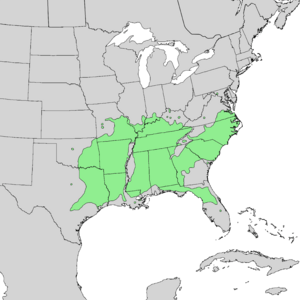Winged elm facts for kids
Quick facts for kids Winged elm |
|
|---|---|
 |
|
| Leaves of U. alata | |
| Conservation status | |
| Scientific classification | |
| Genus: |
Ulmus
|
| Species: |
alata
|
 |
|
| Natural range | |
| Synonyms | |
|
|
The winged elm (scientific name: Ulmus alata), also called wahoo, is a small to medium-sized tree. It loses its leaves every autumn, just like many trees in your backyard. This tree grows naturally only in the woodlands of the southeastern and south-central United States.
The winged elm is quite tough and can grow in many different types of soil. It can even handle areas where water collects! However, it doesn't like a lot of shade. This tree grows slowly, sometimes less than 5 millimeters wider each year. Some people see it as a bit of a nuisance because it easily grows in old fields or cleared forest areas. It can be hard to get rid of once it starts spreading.
Contents
What the Winged Elm Looks Like
The most special thing about the winged elm is right in its name! It has very wide, thin, corky "wings" that grow along its smaller branches after a couple of years. These wings make it easy to spot.
The tree usually grows to about 13 meters (about 43 feet) tall and wide. But in very rich soils, like those near the Mississippi River, some winged elms can grow twice as tall! The top part of the tree, called the crown, can be round or shaped like a pyramid. Its branches often hang down.
Leaves, Flowers, and Seeds
The leaves of the winged elm are quite small compared to other elm trees. They are usually less than 6.5 centimeters (about 2.5 inches) long and less than 2 centimeters (less than an inch) wide. They are thin and smooth, with edges that look like tiny saw teeth. In autumn, these leaves turn a bright yellow color.
The flowers of the winged elm appear in March and April, before the leaves grow. They don't have petals and are pollinated by the wind. The seeds are small, reddish, and shaped like tiny wings. They are usually scattered by the wind before the end of April.
Tree Health: Pests and Diseases
Like other elm trees in North America, the winged elm can get sick from certain diseases. It is very easily affected by Dutch elm disease and Elm Yellows.
Dutch elm disease is a serious fungal disease that can kill elm trees. It is spread by tiny beetles. Elm Yellows is another serious disease caused by very small bacteria-like organisms. It makes the leaves turn yellow and fall off, and can also kill the tree.
Where Winged Elms Grow
The winged elm is not often grown outside of its natural home in the United States. However, it is still grown by tree nurseries in the US. You might sometimes find it for sale in Europe too.
A long time ago, in the early 1800s, the winged elm was one of the American elm trees planted for decoration in Britain. But now, it's quite rare there. You can also find a few specimens growing in New Zealand.
Famous Winged Elm Trees
In some areas, like the rich, silty uplands of the Mississippi Delta, winged elms can reach an amazing height of 27 meters (about 89 feet). However, their trunks usually don't get wider than 60 centimeters (about 24 inches).
In the old Fernbank Forest in Atlanta, Georgia, some winged elms grow up to 39 meters (about 128 feet) tall. A tree even taller, about 40 meters (131 feet) high, has been reported in the Congaree National Park in South Carolina. The current USA National Champion winged elm, which was 27 meters (89 feet) tall in 2009, grows in Hopewell, Virginia.
How People Use Winged Elm Wood
The winged elm is not a very important tree for commercial logging. Its hard wood is similar to other American elms. Because the trees are often small, there's not a lot of wood to use.
However, the wood of the winged elm is very strong and doesn't split easily. Because of this special quality, it is used to make high-quality hockey sticks!
See also
 In Spanish: Ulmus alata para niños
In Spanish: Ulmus alata para niños



